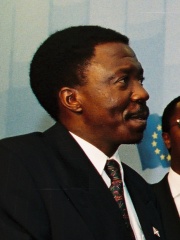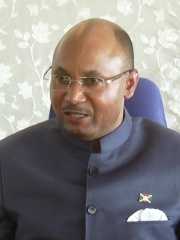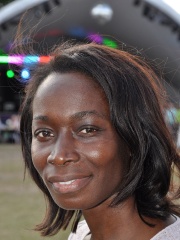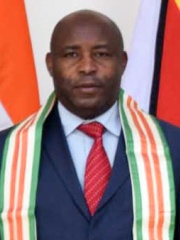
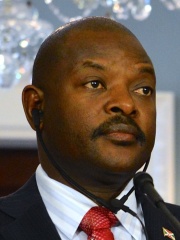
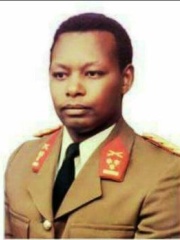
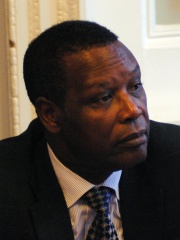
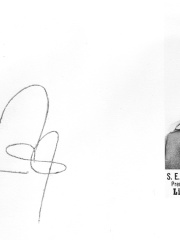
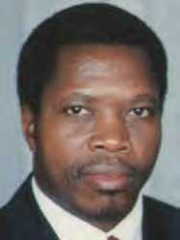
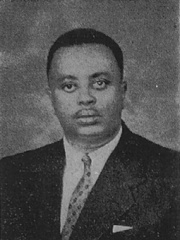
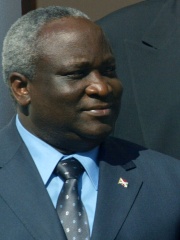
The Most Famous
POLITICIANS from Burundi
This page contains a list of the greatest Burundian Politicians. The pantheon dataset contains 19,576 Politicians, 14 of which were born in Burundi. This makes Burundi the birth place of the 135th most number of Politicians behind Mauritania, and Vanuatu.
Top 10
The following people are considered by Pantheon to be the top 10 most legendary Burundian Politicians of all time. This list of famous Burundian Politicians is sorted by HPI (Historical Popularity Index), a metric that aggregates information on a biography's online popularity. Visit the rankings page to view the entire list of Burundian Politicians.

1. Évariste Ndayishimiye (b. 1968)
With an HPI of 63.33, Évariste Ndayishimiye is the most famous Burundian Politician. His biography has been translated into 41 different languages on wikipedia.
Évariste Ndayishimiye (born 1968) is a Burundian politician who has served as the tenth President of Burundi since 18 June 2020. He became involved in the rebel National Council for the Defense of Democracy – Forces for the Defense of Democracy during the Burundian Civil War and rose up the ranks of its militia. At the end of the conflict, he entered the Burundian Army and held a number of political offices under the auspices of President Pierre Nkurunziza. Nkurunziza endorsed Ndayishimiye as his successor ahead of the 2020 elections which he won with a large majority.

2. Pierre Nkurunziza (1963 - 2020)
With an HPI of 62.69, Pierre Nkurunziza is the 2nd most famous Burundian Politician. His biography has been translated into 73 different languages.
Pierre Nkurunziza (18 December 1964 – 8 June 2020) was a Burundian politician, educator, and rebel leader who served as the ninth president of Burundi from 2005 until his death in 2020. He was the longest-serving president in Burundian history, having served for nearly 15 years. Born into a Hutu family in Bujumbura, Nkurunziza taught physical education before becoming involved in politics during the Burundian Civil War as part of the rebel National Council for the Defense of Democracy – Forces for the Defense of Democracy (Conseil National Pour la Défense de la Démocratie – Forces pour la Défense de la Démocratie, CNDD–FDD) of which he became leader in 2001. The CNDD–FDD became a political party at the end of the Civil War in January 2005 and Nkurunziza was elected president by Parliament in August of that same year. During his first term, Nkurunziza took a number of popular policies. He rebuilt the state from the civil war, and basis of the inter-ethnic compromise enshrined in the Arusha Accords, which recognised the partition of state positions between Tutsi, Hutu, and the minority Twa ethnic groups. Nkurunziza played a major role in the demobilisation of the Party for the Liberation of the Hutu People – National Forces of Liberation (PALIPEHUTU–FNLd), the final Hutu rebel faction in the Civil War in 2008. In 2010, Nkurunziza won a second term despite boycott from opposition parties and accusations of fraud. Nkurunziza's second term was marked by rising discontent and increasing authoritarianism. The repression of opposition members, which began as early as 2008, intensified. In 2014, jogging was banned in the fear of the exercise being a cover up for political meetings. In April 2015, Nkurunziza controversially announced he would run for a third term in the presidential election despite the Arusha Accords stating that there is a two-term limit, which subsequently caused mass unrests. The following month, a failed coup occurred in which Nkurunziza survived and went on to win the election in July. His third term was marked by continuing unrest, consolidation of power, and increasing isolation. In May 2018, a disputed constitutional referendum was held which increased term limits from five to seven years, with a limit of two terms. The following month, when the new constitution came into force, Nkurunziza announced that he will step down after his term ends in 2020. He was subsequently given the title of Supreme Guide of Patriotism (French: Guide suprême du patriotisme) in March 2020. In the May 2020 presidential election, Nkurunziza endorsed ally and protégé Évariste Ndayishimiye as the candidate for the CNDD–FDD. Ndayishimiye subsequently won the election, but Nkurunziza died in the following month in June ahead of the planned transfer of power two months later. His cause of death was disputed as while government sources claimed that Nkurunziza died of a heart attack, other claimed that he died of COVID-19. Eventually, Ndayishimiye was sworn in as president ten days later on 18 June. While credited for rebuilding Burindi and introducing social programs earlier in his presidency, his subsequent authoritarian rule, repression of dissents and human rights abuses later on was heavily criticised.

3. Jean-Baptiste Bagaza (1946 - 2016)
With an HPI of 61.25, Jean-Baptiste Bagaza is the 3rd most famous Burundian Politician. His biography has been translated into 34 different languages.
Jean-Baptiste Bagaza (29 August 1946 – 4 May 2016) was a Burundian army officer and politician who ruled Burundi as president and de facto military dictator from November 1976 to September 1987. Born into the Tutsi ethnic group in 1946, Bagaza served in the Burundian military and rose through the ranks under the rule of Michel Micombero after his rise to power in 1966. Bagaza deposed Micombero in a bloodless coup d'état in 1976 and took power himself as head of the ruling Union for National Progress (Union pour le Progrès national, UPRONA). Despite having participated in the genocidal killings of 1972, he introduced various reforms which modernised the state and made concessions to the country's ethnic Hutu majority. His regime became increasingly repressive after it became consolidated in 1984, especially targeting the powerful Catholic Church. His rule lasted until 1987 when his regime was overthrown in a further coup d'état and he was forced into exile. He returned to Burundi in 1994 and became involved in national politics as the leader of the Party for National Recovery (Parti pour le Redressement National, PARENA). He died in 2016.

4. Pierre Buyoya (1949 - 2020)
With an HPI of 60.59, Pierre Buyoya is the 4th most famous Burundian Politician. His biography has been translated into 35 different languages.
Pierre Buyoya (24 November 1949 – 17 December 2020) was a Burundian army officer and politician who served as the seventh president of Burundi from 1996 to 2003. Having previously served as the fifth president from 1987 to 1993, Buyoya was the second-longest-serving president in Burundian history, after Pierre Nkurunziza. An ethnic Tutsi, Buyoya joined the sole legal party, UPRONA and quickly rose through the ranks of the Burundian military. In 1987, he led a military coup d'état that overthrew his predecessor Jean-Baptiste Bagaza and enabled him to seize power. Leading an oppressive military junta, Hutu uprisings in 1988 led to the killings of an estimated 20,000 people. Buyoya then established a National Reconciliation Commission that created a new constitution in 1992 which allowed for a multi-party system and a non-ethnic government. Running as a candidate in the 1993 Burundian presidential election, he was defeated by Hutu candidate Melchior Ndadaye of the FRODEBU opposition party. Ndadaye was assassinated during another attempted coup after only three months in office, leading to a series of retaliatory killings that culminated in the Burundian Civil War. During the war, Buyoya returned to power in another coup d'état in 1996. During his second presidency, he created an ethnically inclusive government by establishing a partnership with FROBEDU. This led to the 2000 Arusha Accords which introduced ethnic power sharing. He selected Domitien Ndayizeye, a Hutu as his vice-president, who succeeded him as president in 2003. The war ended two years later. Following the end of the war, Buyoya became a senator for life under the terms of the 2004 constitution. During his post-presidency, he was also sent as an African Union envoy during peace missions in Chad and Mali. In November 2020, he was sentenced to life in prison in absentia by a Burundinan court for his suspected role in the 1993 coup attempt that assassinated Ndadaye. He died of COVID-19 two months later.
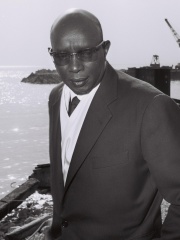
5. Mwambutsa IV of Burundi (1912 - 1977)
With an HPI of 60.54, Mwambutsa IV of Burundi is the 5th most famous Burundian Politician. Her biography has been translated into 20 different languages.
Mwambutsa IV Bangiricenge (6 May 1912 – 26 March 1977) was the penultimate king (mwami) of Burundi who ruled between 1915 and 1966. He succeeded to the throne on the death of his father Mutaga IV Mbikije (reigned 1908–15). Born while Burundi was under German colonial rule, Mwambutsa's reign mostly coincided with Belgian colonial rule (1916–62). The Belgians retained the monarchs of both Rwanda and Burundi under the policy of indirect rule.

6. Michel Micombero (1940 - 1983)
With an HPI of 60.13, Michel Micombero is the 6th most famous Burundian Politician. His biography has been translated into 33 different languages.
Michel Micombero (26 August 1940 – 16 July 1983) was a Burundian military officer and politician who ruled the country as de facto military dictator for the decade between 1966 and 1976. He was the last Prime Minister of the Kingdom of Burundi from July to November 1966, and the first President of the country from November 1966 until his overthrow in 1976. Micombero was an ethnic Tutsi who began his career as an officer in the Burundian military at the time of Burundi's independence in 1962. He studied abroad and was given a ministerial portfolio on his return. He rose to prominence for his role in helping to crush an attempted coup d'état in October 1965 by ethnic Hutu soldiers against the Tutsi-dominated monarchy. In its aftermath, in 1966, Micombero himself instigated two further coups against the monarchy which he perceived as too moderate. The first coup in July installed a new king on the throne, propelling Micombero to the role of prime minister. The second coup in November abolished the monarchy itself, bringing Micombero to power as the first president of the new Republic of Burundi. Micombero led a one-party state which centralised the country's institutions and adopted a neutral stance in the Cold War. Dissent was repressed and, in 1972, an attempt to challenge Micombero's power led to genocidal violence against the Hutu population in which around 100,000 people, mainly Hutus, were killed. His regime finally collapsed in 1976 when he was ousted in a coup d'état by another army officer, Jean-Baptiste Bagaza, who installed himself as president. Micombero went into exile in Somalia, where he died in 1983.

7. Cyprien Ntaryamira (1955 - 1994)
With an HPI of 59.62, Cyprien Ntaryamira is the 7th most famous Burundian Politician. His biography has been translated into 32 different languages.
Cyprien Ntaryamira (6 March 1955 – 6 April 1994) was a Burundian politician who served as President of Burundi from 5 February 1994 until his death two months later in the context of the Burundian Civil War. A Hutu born in Burundi, Ntaryamira studied there before fleeing to Rwanda to avoid ethnic violence and complete his education. Active in a Burundian student movement, he cofounded the socialist Burundi Workers' Party and earned an agricultural degree. In 1983, he returned to Burundi and worked agricultural jobs, though he was briefly detained as a political prisoner. In 1986 he cofounded the Front for Democracy in Burundi (FRODEBU), and in 1993 FRODEBU won Burundi's general elections. He subsequently became the Minister of Agriculture and Animal Husbandry on 10 July under the rule of Burundi's new FRODEBU president Melchior Ndadaye, but in October Tutsi soldiers killed Ndadaye and other top officials in an attempted coup, inciting the civil war. Ntaryamira survived the putsch and in January 1994 the National Assembly elected him to succeed Ndadaye as the President of Burundi. After a prolonged constitutional dispute, he was inaugurated on 5 February, declaring that his top priorities would be restoring peace, promoting human rights, and resettling refugees. Throughout his tenure he unsuccessfully sought to mitigate ethnic conflict. He was killed on 6 April 1994 when the plane he was travelling in with Rwandan President Juvénal Habyarimana was shot down over Kigali.

8. Louis Rwagasore (1932 - 1961)
With an HPI of 59.46, Louis Rwagasore is the 8th most famous Burundian Politician. His biography has been translated into 17 different languages.
Prince Louis Rwagasore (Kirundi: Ludoviko Rwagasore; 10 January 1932 – 13 October 1961) was a Burundian prince and politician, who was the second prime minister of Burundi for two weeks, from 28 September 1961 until his assassination on 13 October. Born to the Ganwa family of Burundian Mwami (king) Mwambutsa IV in Belgian-administered Ruanda-Urundi in 1932, Rwagasore was educated in Burundian Catholic schools before attending university in Belgium. After he returned to Burundi in the mid-1950s he founded a series of cooperatives to economically empower native Burundians and build up his base of political support. The Belgian administration took over the venture, and as a result of the affair his national profile increased and he became a leading figure of the anti-colonial movement. He soon thereafter became involved with a nationalist political party, the Union for National Progress (UPRONA). He pushed for Burundian independence from Belgian control, national unity, and the institution of a constitutional monarchy. Rwagasore sought to bring UPRONA mass appeal across different regions, ethnicities, and castes, and under him the party maintained a leadership balanced between ethnic Hutus and Tutsis, though the latter were usually favoured for more important positions. The Belgian administration disliked UPRONA and initially attempted to stifle Rwagasore's activities, placing him under house arrest in 1960 during municipal elections. International pressure led the administration to back down, and the following year UPRONA won an overwhelming majority in the legislative elections. As a result, Rwagasore became prime minister of Burundi on 28 September 1961. Two weeks later, he was shot by a Greek national at the direction of leaders of a rival political party with the probable support of the Belgian Resident in Burundi. Rwagasore's death derailed his attempts to build national ethnic cohesion and facilitated the growth of Hutu–Tutsi tensions in the country. It also fractured UPRONA, as his former lieutenants engaged in a power struggle to succeed him as the party's leader. Within Burundi, Rwagasore enjoys nearly universal acclaim, and his assassination is commemorated annually with large ceremonies. He remains relatively unknown internationally in comparison to other leaders of independence movements in the African Great Lakes region.

9. Domitien Ndayizeye (b. 1951)
With an HPI of 56.97, Domitien Ndayizeye is the 9th most famous Burundian Politician. His biography has been translated into 30 different languages.
Domitien Ndayizeye (born 2 May 1953) is a Burundian politician who served as the eighth president of Burundi from 2003 to 2005. A member of the Front for Democracy in Burundi (FRODEBU), he previously served as the first vice president under President Pierre Buyoya from 2001 to 2003. Ndayizeye currently serves as head of the National Gathering for Change (Rassemblement National pour le Changement, RANAC). In 1994 he was appointed director of the National Intelligence Service by President Cyprien Ntaryamira. In 2004, Ndayizeye proposed a draft constitution to the parliament prior to it being put to the electorate in referendum later in the year. Relations with the Tutsi group were strained, reflected in their boycotting of the legislative session due to consider the proposal. Due to a lack of preparation, the ballot was postponed to late November 2004. Burundi is still trying to emerge from a civil war that began in 1993 when several groups drawn from the large Hutu majority took up arms against a government and army then dominated by a Tutsi elite. The interim government pledged to more equitably share power between the two main ethnic groups. On 21 August 2006, Ndayizeye was arrested in Bujumbura in relation to his alleged role in a coup plot earlier in the year. The Senate lifted his immunity as Senator prior to his arrest. He denied the charges against him in court on December 19 and said that he had "never dreamed of organising a coup, in fact I had given up politics to do business and be with my family". On January 15, 2007, he was acquitted along with former vice president Alphonse-Marie Kadege and three other defendants; two others were sentenced to long prison terms. During 2010 general elections, as his party representative, he ran for the presidential seat but decided to withdraw from the race together with all opposition parties, after they accused the ruling party of rigging previous councilors' elections. After opposition politician Zedi Feruzi was killed during the 2015 Burundian unrest Ndayizeye and other opposition parties broke off talks with the government of President Pierre Nkurunziza.
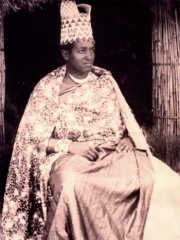
10. Ntare V of Burundi (1947 - 1972)
With an HPI of 55.17, Ntare V of Burundi is the 10th most famous Burundian Politician. His biography has been translated into 20 different languages.
Ntare V of Burundi (born Charles Ndizeye; 2 December 1947 – 29 April 1972), less commonly numbered Ntare III, was the last king (mwami) of Burundi, reigning from July to November 1966. Until his accession, he was known as Crown Prince Charles Ndizeye. He seized power in July 1966 by deposing his own father. He reigned until November, when prime minister Michel Micombero overthrew him, ending the Burundian monarchy. He went into exile but returned in 1972, only to be swiftly arrested by the republican government. Later that year, during a period of mass violence called the "Ikiza", he was killed under unclear circumstances.
People
Pantheon has 14 people classified as Burundian politicians born between 1912 and 1972. Of these 14, 6 (42.86%) of them are still alive today. The most famous living Burundian politicians include Évariste Ndayishimiye, Domitien Ndayizeye, and Sylvestre Ntibantunganya. The most famous deceased Burundian politicians include Pierre Nkurunziza, Jean-Baptiste Bagaza, and Pierre Buyoya. As of April 2024, 1 new Burundian politicians have been added to Pantheon including Gervais Ndirakobuca.
Living Burundian Politicians
Go to all RankingsÉvariste Ndayishimiye
1968 - Present
HPI: 63.33
Domitien Ndayizeye
1951 - Present
HPI: 56.97
Sylvestre Ntibantunganya
1956 - Present
HPI: 53.10
Alain-Guillaume Bunyoni
1972 - Present
HPI: 51.20
Nyamko Sabuni
1969 - Present
HPI: 48.08
Gervais Ndirakobuca
HPI: 45.89
Deceased Burundian Politicians
Go to all RankingsPierre Nkurunziza
1963 - 2020
HPI: 62.69
Jean-Baptiste Bagaza
1946 - 2016
HPI: 61.25
Pierre Buyoya
1949 - 2020
HPI: 60.59
Mwambutsa IV of Burundi
1912 - 1977
HPI: 60.54
Michel Micombero
1940 - 1983
HPI: 60.13
Cyprien Ntaryamira
1955 - 1994
HPI: 59.62
Louis Rwagasore
1932 - 1961
HPI: 59.46
Ntare V of Burundi
1947 - 1972
HPI: 55.17
Newly Added Burundian Politicians (2025)
Go to all RankingsOverlapping Lives
Which Politicians were alive at the same time? This visualization shows the lifespans of the 8 most globally memorable Politicians since 1700.

